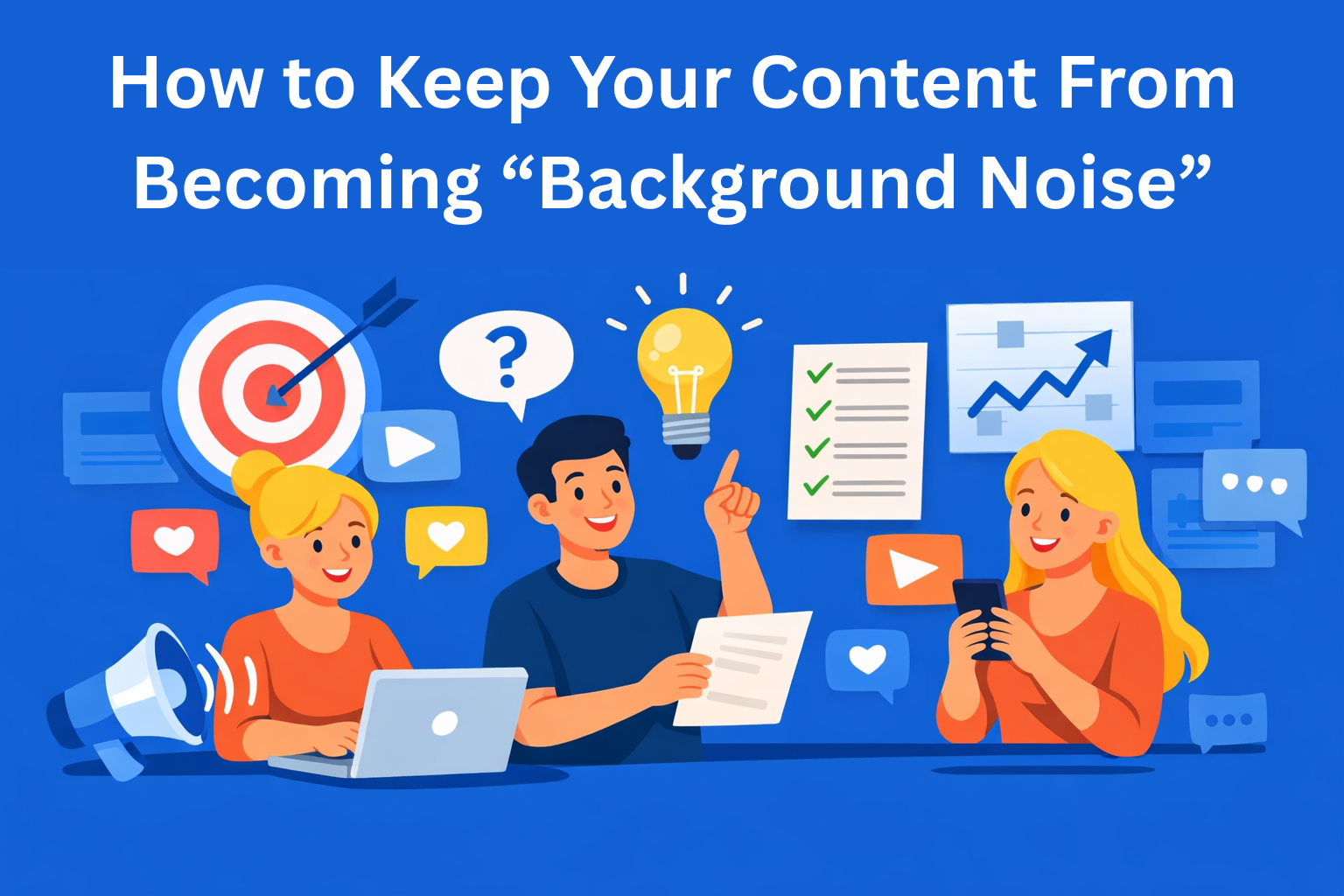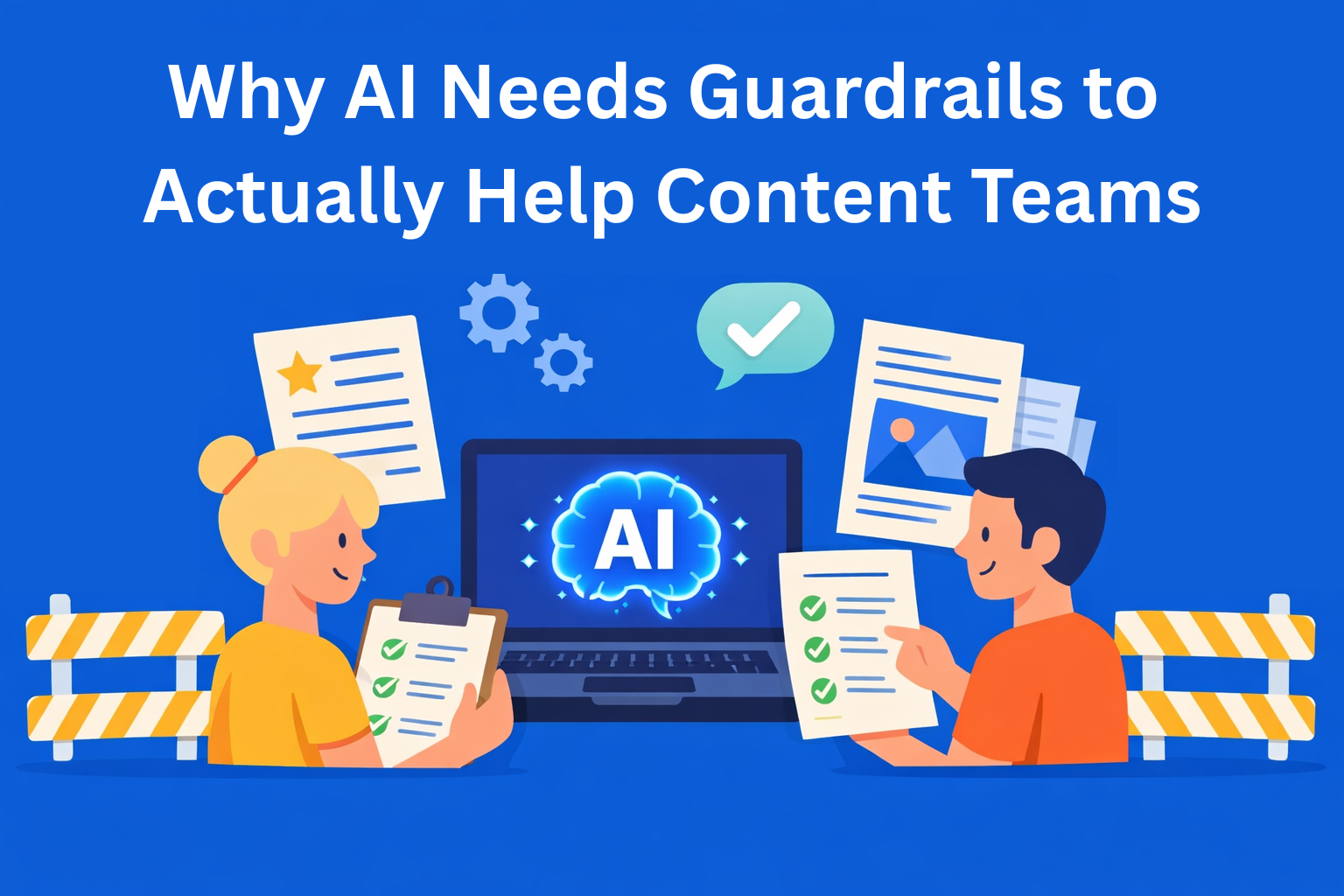AI's Place in Teams Working on Content Creation
AI transforms content teams, boosting efficiency, streamlining workflows, and enhancing personalization. From ideation to approvals, tools like EasyContent help teams balance automation with creativity for faster, smarter, and human-centered content creation.
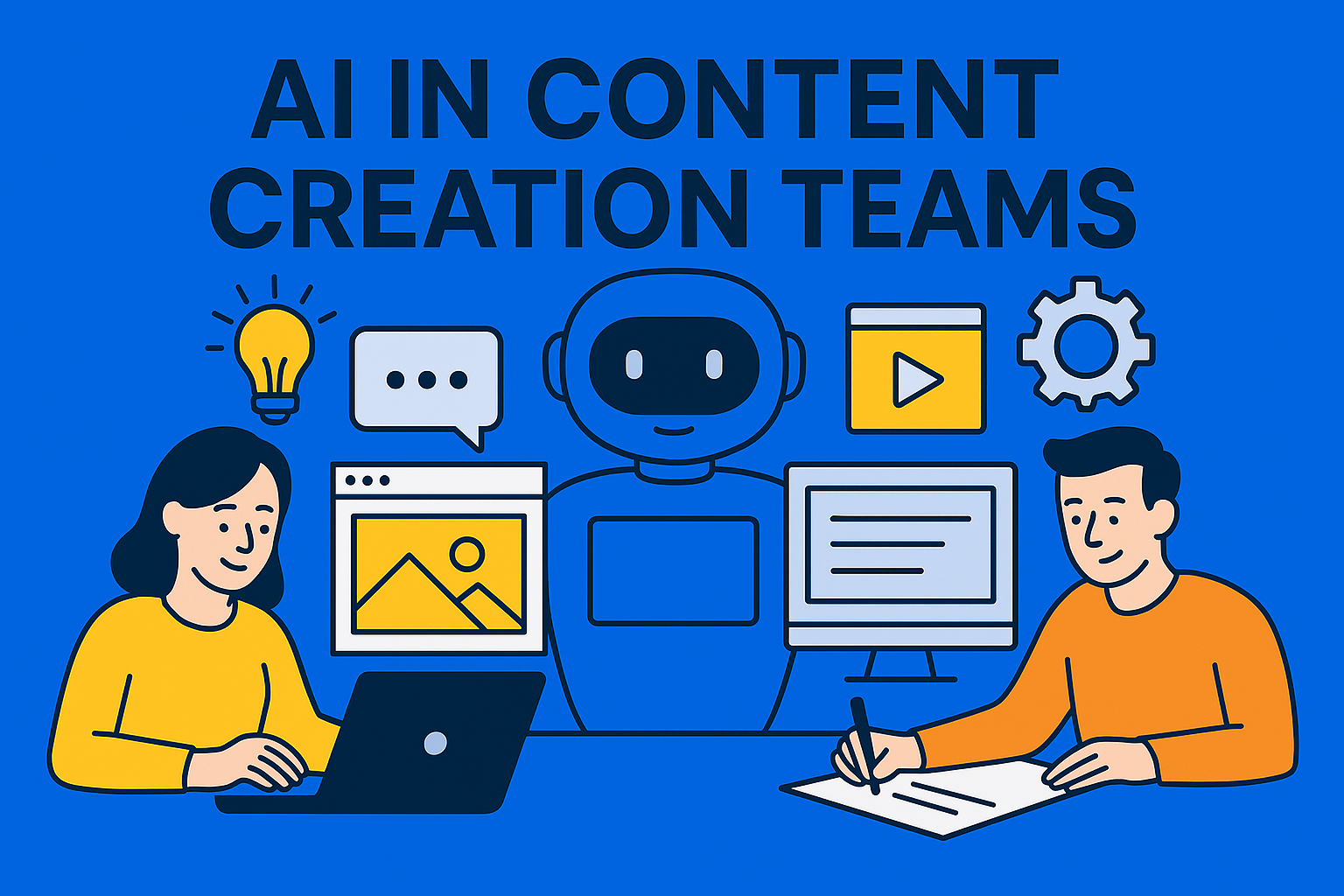
How AI Fits Into Teams Working on Making Content
AI is not a sci-fi idea; it is already changing how content teams work. AI is making content creation faster, better, and more efficient by automating tasks and giving us insights based on data. First, though, AI isn't here to take the place of human creativity. Instead, it is a powerful tool that helps teams come up with new ideas, make processes more efficient, and personalize a lot of information. AI is being used by many businesses today to meet the growing demand for great, interesting content.
With the help of AI-powered tools, marketers can do more with less, including
🎯 tracking the crowd
🗓️automatic posting of content
✍️ Writing suggestions based on AI
Still, the key to success is using AI without taking away from the human part.
AI may give us new ideas and make jobs easier, but we still need human knowledge for:
- Telling Stories
- Voice of the brand
- A mental link
Why content teams need AI for growth and efficiency
Without AI, content teams often have trouble meeting tight targets and moving slowly through human tasks.
Imagine a content manager who is responsible for many blog drafts, social posts, and campaign assets and has to coordinate the work of artists, writers, and editors.
Without automation, there are delays, permits take longer, and work gets done less quickly.
To help, AI does things like topic research, grammar checks, and keeping track of results that need to be done over and over again.
This lets content teams focus on planning and coming up with new ideas. For instance, AI can look at past success data and offer content topics that people are likely to be interested in. This saves time and takes away the need to guess.
EasyContent helps with workflows that are powered by AI
Even though AI tools help with making content, teams still need a structured process to keep track of everything. We can help with that with EasyContent.
EasyContent makes it easy for teams to plan, create, and review content—everything in one place.
Teams can work together instantly, see how things are going, and avoid the chaos of moving between tools by putting AI-driven insights right into the process.
As a result? You'll get a faster, smarter, and more in line with your goals content process.
Key Takeaways
- AI enhances content creation but doesn't replace human creativity.
- Automation helps streamline repetitive tasks like scheduling and formatting.
- AI improves research with real-time data analysis and keyword suggestions.
- Content personalization driven by AI boosts engagement and relevance.
- EasyContent integrates AI workflows while maintaining team efficiency.
- Human oversight is essential for storytelling, tone, and ethical use of AI.
Discovering the Areas Where AI Could Greatly Improve the Process of Making Content
AI isn't just something from the future; it's already changing how content teams grow, automate, and plan. To get the most out of AI, teams need to figure out where it adds the most value, like automating boring jobs, making study better, or letting people make things very specific to them.
⚙️ Automating Tasks Like Scheduling Content and Formatting
One of AI's best skills is being able to do boring, routine tasks that slow down creative teams.
✅Most often, automatic tasks include:
- Putting digital goods in order
- Getting blog posts ready
- Planning material for social media
- Putting together emails, blogs, and landing pages
AI can automatically arrange and style posts based on brand rules. This saves time, cuts down on mistakes, and lets teams focus on creating high-quality content.
📊 AI-powered research: finding trends and suggesting keywords
AI helps content teams make better choices more quickly by studying huge amounts of data in real time. AI gives people real information instead of thinking what they want.
🔎How AI helps with research:
- Analysis of industry trends
- Finding the most effective keywords
- Analysis of how people feel about public words and thoughts
- Content study of competitors
🎯Big-Scale Personalization
Customization is no longer a nice-to-have, users expect it. AI makes it possible for appropriate material to be sent automatically to users based on their actions and preferences.
🔁Personalizes with AI:
- Calls to action and headlines
- Emails and when they were sent
- Thoughts on certain books, goods, or services
📈 The Result: The result was more interaction, more sales, and a more loyal following.
| Problem | AI-Powered Solution | Result |
|---|---|---|
| Inconsistent publishing pace | Automated scheduling | Stable and consistent output |
| Time-consuming research | AI-generated topic and keyword suggestions | More focused strategy |
| Lack of personalization | AI recommendations based on user behavior | Higher relevance and engagement |
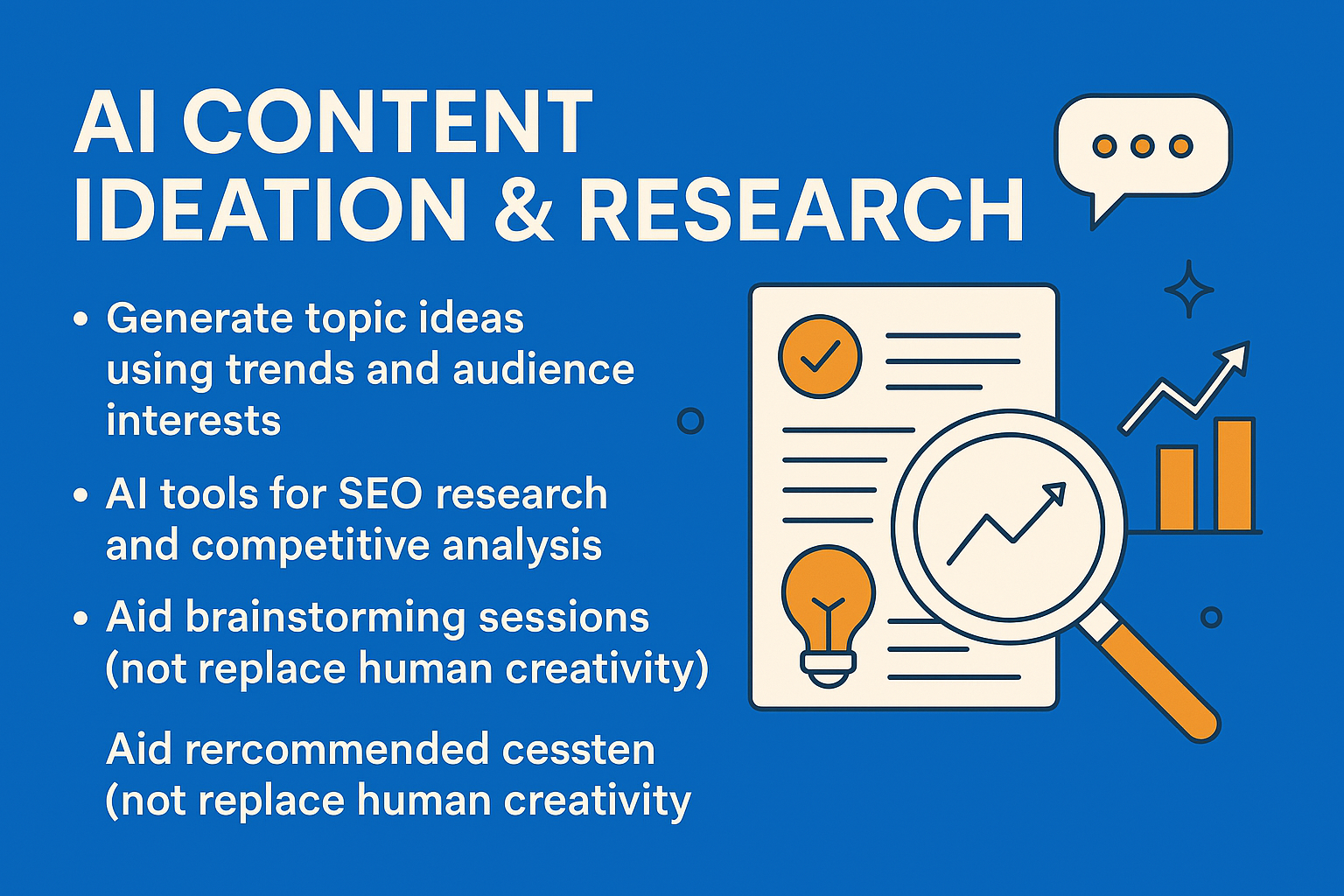
AI Content Ideation & Research
One of the hardest things content teams have to do is come up with original and interesting concepts. Many times, writers and marketers have a creativity block; hence, investigating popular subjects can take time and be intimidating. Here is where artificial intelligence might be useful: by means of data-driven insights, trend identification, and competitive analysis simplification,
Though technology may speed up research, highlight pertinent issues, and enhance brainstorming sessions—all while allowing editorial expertise—AI is not ready to replace human creativity.
Using trends and audience interests, how may artificial intelligence create topic ideas?
AI-driven systems may examine industry trends, search habits, and audience involvement to offer high-performance content ideas rather than speculating about what subjects will appeal.
To find hot issues and new trends, for instance, AI-powered systems can examine Google searches, social network debates, and news headlines. This enables content teams to provide pertinent social media, blog, and article materials in line with consumer searches.
AI-driven content curation—where AI algorithms recommend similar subjects depending on performance—is a fantastic application case. Content teams can rapidly uncover inspiration and concentrate on creating gripping stories rather than spending hours investigating.
Tools Driven by Artificial Intelligence for SEO Research and Competitive Analysis
While monitoring the competition is crucial, personally examining rival blogs, rankings, and keywords is somewhat labor-intensive. By examining rival websites, spotting best-performing keywords, backlink techniques, and content gaps, artificial intelligence streamlines this.
AI-powered SEO solutions may assist teams in:
✔ Finding low-keywords with less competition.
✔ Suggest content improvements grounded on search intent.
✔ Highlight materials without coverage by rivals yet.
These revelations will help content makers create strategic, fact-based material that ranks higher and reaches the proper audience.
Using AI to facilitate brainstorming sessions without sacrificing human ingenuity
As a brainstorming partner, artificial intelligence may assist teams create perspectives, headlines, and content variants depending on a given theme. AI improves the process by providing ordered recommendations that inspire fresh ideas, not by substituting human thoughts.
Content teams may, for example, use artificial intelligence to create many headline variants and choose the most interesting one.
✔ Get recommended content outlines with a methodical approach to challenging subjects.
✔ Look at other, maybe unthought-of viewpoints.
AI does not, however, possess human intuition or emotional depth, hence this should be remembered. AI-generated ideas should be polished by writers and editors to guarantee they complement the brand voice and messaging.
Juggling editorial expertise with AI-generated ideas
Though AI systems might provide an excessive volume of subject ideas, keyword lists, and data insights, this does not mean every proposal should be applied exactly as suggested. Filtering out useless or generic ideas and guaranteeing that material is interesting, useful, and original depend on human control.
One sensible way to combine editorial knowledge with AI-driven research is Though authors alter the story, add originality, and give the material individuality, AI may recommend what subjects to include.
Writing Under AI: Simplifying Content Creation
Content creation has never happened overnight. From concept development to text structure, editing, and optimization, writers balance various tasks. Artificial intelligence powered writing aids have come in to help teams run faster without sacrificing standards by simplifying this procedure. Applied correctly, artificial intelligence technology might boost productivity, accuracy, and overall writing experience while also improving general quality of living.
AI-powered writing assistants: their benefits
Artificial intelligence writing tools from Grammarly, Jasper, and Copy ai will be transformative for content teams. These tools have uses for:
- Check grammar and spelling. To ensure professional material, artificial intelligence detects typos, punctuation errors, and strange terminology.
- Style and tone evolve. Many technologies look at sentence structure and provide modifications to maintain brand voice constant.
- Manufacturing materials. Drafting blog ideas, ad language, and product descriptions—AI-driven technologies assist you overcome writer's block.
- Maximizing SEO Many programs suggest keyword placements and readability improvements to improve search results.
Instead of replacing writers, artificial intelligence is a writing pal that helps to refine content and speeds the process.
How AI Corrects Grammar, Structure, and Content Optimization
One of the biggest difficulties writers have is organizing their ideas into cogent, appealing material. AI systems can look at phrase flow, suggest better transitions, and identify reading difficulties. This especially helps authors aiming for digital readers who quickly glance over content.
Among many other things, artificial intelligence could:
- For easier reading, suggest shorter, more quickly digestible paragraphs.
- Point up passive voice or wordiness that could skew the meaning.
- Suggest headline adjustments that raise click-through rates.
AI might also look at keyword density, suggest metadata changes, and guarantee material fulfills search intent when coupled with technologies aimed at SEO.
Maintaining brand authenticity and voice
One common concern concerning AI-generated content is losing the unique brand voice. Sometimes artificial intelligence creates broad, robotic-sounding, devoid of uniqueness language. For this reason, human oversight is fairly crucial. Authors should review, edit, and modify AI-generated materials to match their readership.
Best approaches for preserving authenticity of AI-assisted content:
- Use artificial intelligence for outlines and early drafts; yet, provide a human touch before publishing.
- Always fact-check documents created by artificial intelligence to avoid misleading information.
- Customize AI recommendations to complement the own message and look of the brand.
Guidelines for Composing Human-AI Cooperation
Teams aiming to optimize AI-assisted writing should find the perfect combination between automation and human creativity.
- By managing repetitious chores such syntax, formatting, and summary, artificial intelligence may save you time.
- Consider AI-generated text as a starting point rather than the definitive form.
- With tools like EasyContent, which lets teams examine, change, and approve AI-enhanced versions without sacrificing creative control, invite artificial intelligence into team projects.
How EasyContent supports teams managing AI-assisted initiatives
Teams may find it difficult to evaluate, approve, and edit drafts even if AI-powered systems can create material fast without a set method. Simple Content makes groups easier:
- Organize generated artificial intelligence texts and send them to editors for human improvement.
- Simplify comments and approval if you wish standards of quality kept intact.
- From idea to print, track materials in a consolidated system.
Combining AI technologies with organized procedures lets teams increase output, so ensuring that material is brand-aligned, premium, and engaging.
Improving Proofreading and Content Editing with AI
Essential parts of content development, editing and proofreading guarantee that every work is polished, clear, and interesting. These chores may be time-consuming, too, particularly for teams generating a lot of material. AI-powered technologies have entered the scene to speed up and simplify the process, therefore enabling editors and authors to hone their work without compromising quality.
AI Tools for Style and Grammar Checking
Grammar and style checking is among the most often used applications of artificial intelligence in editing. Real-time text analysis tools such Grammarly, Hemingway Editor, and ProWriting Aid identify mistakes and offer suggestions for corrections.
They aid as follows:
- Correcting grammar and spelling guarantees that little mistakes never escape.
- Suggestions for punctuation help to clarify and simplify sentences.
- Analysis of tone and style helps to keep the voice constant across the work.
AI guarantees that material is polished and professional before publication by spotting errors that would be missed in hand proofreading.
Using AI Suggestions to Improve Consistency and Readability
Because of their short attention spans, readers of today must find material easily readable and understandable. By recommending, AI tools assist to increase readability by:
- Simpler phrase forms to help material to be more easily consumed.
- Improved clarity and impact via stronger word choices.
- Consistent formatting following the style guide of a brand.
An AI technology can recommend shorter, more interesting phrases for a blog article if its long, sophisticated lines call for breaking down. This increases general understanding and helps the reader to remain interested.
Sentiment Analysis Driven by AI for Enhanced Audience Alignment
Beyond simple grammar and style check, sentiment analysis driven by artificial intelligence helps content teams know how their work connects with their readers.
AI instruments are capable of:
- Find in materials either positive, neutral, or negative tones.
- Offer changes to fit brand messaging and audience expectations.
- Whether it's persuading, instructive, or amusing, help make sure material matches the expected emotional appeal.
AI may identify a marketing email, for instance, if it seems too official for an audience who likes casual communications and suggest changes. This guarantees that material always speaks to the appropriate individuals in the appropriate manner.
How EasyContent Simplifies Content Approvals and Review
Content teams still require a disciplined process even with AI-powered editing to guarantee excellent output. EasyContent here comes in handy.
EasyContent aids in teams:
- Work on approvals and edits together without tracking changes.
- Assign editing tasks so every bit of material receives a careful check-through.
- Keep version control to avoid confusing obsolete drafts.
- Organize comments such that recommendations aren't dispersed throughout emails or chat threads.
Teams can guarantee material conforms with brand standards, increase accuracy, and accelerate approvals by combining AI-powered editing with a well-ordered content pipeline.
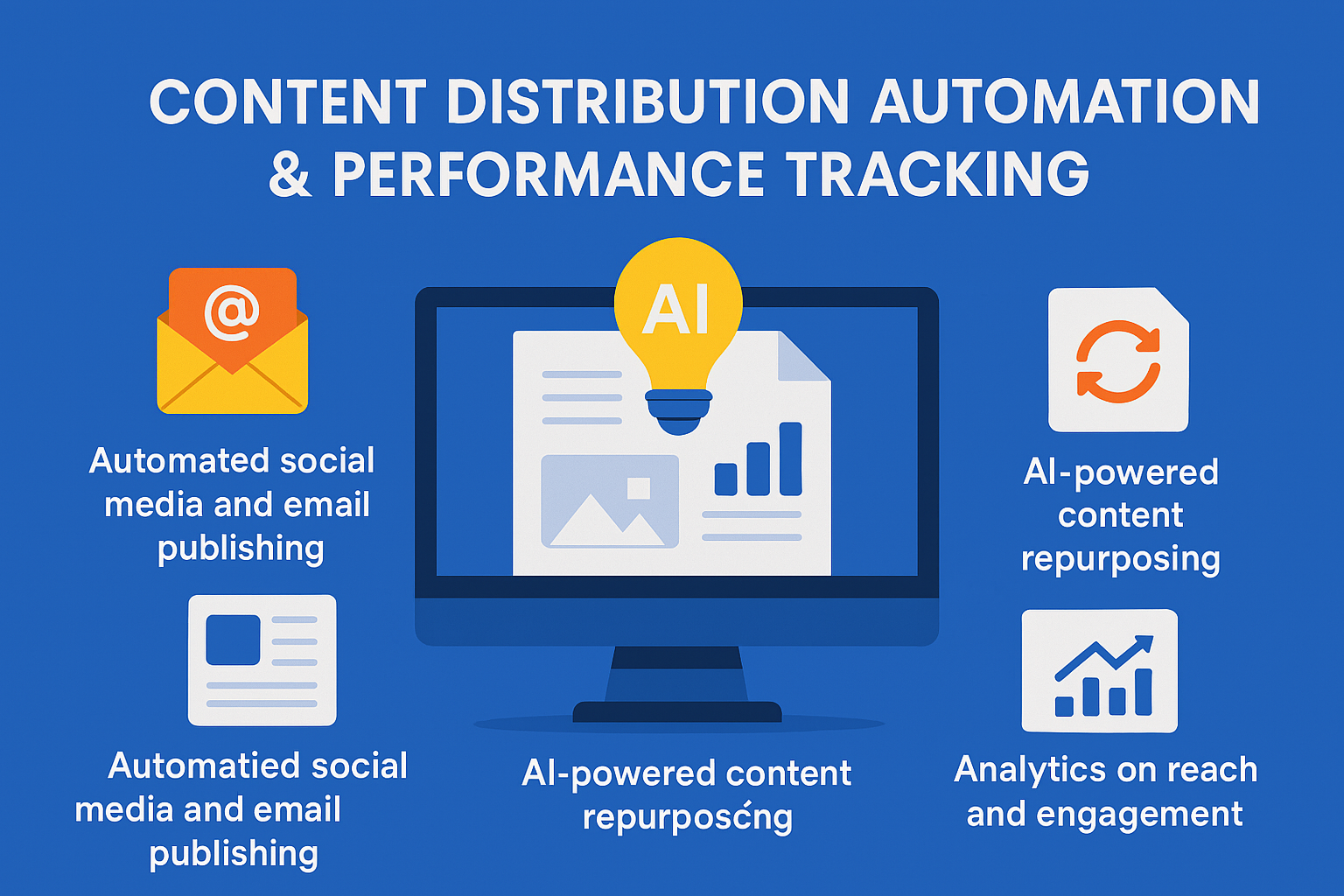
Content Distribution Automation & Performance Tracking Automation
Making excellent material is only half the fight; the true difficulty is bringing it before the proper audience at the proper moment. Content distribution by hand over several channels may be labor-intensive and ineffective. AI-powered automation then comes in to speed content dissemination, smartly, and effectively. Content teams may optimize reach without adding more effort by using AI for publishing, reusing, and performance tracking.
Using AI for email marketing and automated social media posting
Maintaining current with social media plans and email marketing initiatives may be taxing. By means of AI-powered solutions, these tasks are automated, therefore guaranteeing consistent and strategic delivery of material.
AI advances content distribution in the following ways:
- AI systems examine interaction trends and plan postings at best periods in automated social media. To keep posts fresh, sites like Buffer and Hootsuite even recommend content variances.
- AI solutions tailor email subject lines, segment audiences, and maximize send timings for better open and click-through rates.
- Based on prior encounters, artificial intelligence (AI) forecasts what kind of material would be most successful and modifies the approach.
An AI-driven scheduling tool, for instance, may find when your audience is most engaged and then automatically publish material to increase interaction.
Content Repurposing Driven by AI for Various Platforming
Not every audience views materials the same way. While some like reading blog entries, others interact better with podcasts, videos, or social media snippets. AI helps reuse current material into several formats rather than producing fresh stuff from scratch.
Methods AI facilitates content repurposing:
- Creating social media carouels or infographics from blog entries.
- Pulling important ideas from long-form material to produce LinkedIn or Twitter threads.
- Turning video transcripts into emails or articles or newsletters.
- Automatically compassing webinars or interviews into bit-sized snippets.
In minutes, an AI-powered application may, for example, extract salient features from a 1,500-word blog piece and rework them into a LinkedIn post, an Instagram carousel, and an email newsletter.
Monitoring Key Performance Measures with Analytics Driven by AI
Refining tactics and optimizing return on investment depend on content performance being measured. Real-time tracking of important data and actionable insights made possible by AI-powered analytics tools help.
AI instruments can track:
- Likes, shares, comments, and content time spent define engagement metrics.
- Traffic Sources: Finding the platforms most frequented by visitors.
- Measuring readers' actions—sign-ups, purchases, etc.—helps one to determine conversion rates.
- Comparing many headlines, graphics, or formats helps A/B testing results show what performs best.
AI compiles all of the data from several dashboards into a single report, therefore freeing content teams to concentrate on strategy rather than data collecting instead of physically dragging data from several dashboards.
Combining AI with EasyContent for seamless collaboration and automation performs best when matched with a methodical content creation process. Here is where EasyContent is absolutely vital. Teams using AI techniques together with EasyContent can:
- Schedule materials automatically while tracking deadlines and approvals.
- Organizing AI-generated content drafts will help to simplify reuse procedures.
- Using built-in editing and approval procedures guarantees content quality before publication.
- Track performance indicators on one platform to hone next content plans.
EasyContent, for instance, may enable teams to monitor content development, control AI-generated drafts, and guarantee final approvals—all while maintaining continuous communication.
Overcoming Challenges and Ethical Concerns Regarding AI in Content
AI is simplifying procedures and also accelerating the creation of content. Still, this simplicity of usage has several flaws. Stories should have a human touch, ethics, truthfulness, and morality questioned. Though technology may assist with things like learning, writing, and optimization, artificial intelligence should be used wisely and sensibly.
Correcting Issues using the accuracy of AI produced content The fact that artificial intelligence produced information is not always accurate is one of the key issues with it. Although artificial intelligence systems obtain data from previously existing sources, they might provide erroneous, antiquated, or biassed information or acquire the data incorrectly. For companies depending on reliable news, legal papers, or information pertinent to their sector, this can be a major issue.
In terms of accuracy:
✅Always check the facts of AI-made content before sharing it.
📚Use AI to help with study, not just to make material.
🔍Use trustworthy sources to check AI-suggested data across multiple dimensions.
A great example of this is a marketing team that uses AI to create blog outlines but still needs human writers to check the numbers, reinterpret parts, and give their professional views.
Avoiding relying too much on AI—keeping the human touch in story development
Even though telling stories is an art form that requires human creativity, AI is great for getting things done quickly. Artificial intelligence can make content seem robotic, general, and disconnected from real feelings if it is used too much. Many times, readers can tell when something isn't real, which hurts trust and interest.
Ways to keep the story real while using AI:
💡Use AI to help you get ideas, even though you write in a human voice. AI may come up with ideas and drafts, but writers will still need to polish the work to show brand personality and emotional depth.
🗣️Combine information from the real world with thoughts made by AI. Adding personal stories, quotes from clients, or professional opinions is a good way to add useful, trustworthy information.
🎨AI should not replace artistic work, but rather make it better. AI systems can suggest how to organize and style content, but people are the ones who add empathy and creativity, which make it really interesting.
AI can write things like product descriptions, but only a great writer can make them sound real and tailored to the reader, not like they were written by a computer.
Making sure that AI tools follow the rules of law and ethics
Companies need to make sure that the material they use that is driven by AI is in line with moral and legal standards as AI gets smarter. Issues like copying, bias, and the protection of user data need to be fixed.
Most important moral issues:
✍️Do not plagiarize; artificial intelligence sometimes takes information from other sources without giving credit. Always change text that was made by AI to make it stand out.
⚖️Taking biases from the data AI learns from and reflecting them helps to lessen their effects. Content staff should check content made by AI for bias that was not meant to be there.
🛡️Follow the rules about privacy: User input is needed for personalized AI to work. Make sure that AI systems follow the GDPR, CCPA, and other rules for keeping data safe.
The best ways to incorporate responsible AI
If businesses want to use AI in content production in a way that is both efficient and moral, they should follow these best practices:
🔍Make it clear which tasks AI can help with (like research and SEO optimization) and which ones need human supervision (like final edits and tone).
📚Teach teams about the ethics of artificial intelligence and make sure that people who make content know what AI can and can't do.
🛡️Use AI-powered systems that put openness first; for example, EasyContent lets teams keep an eye on AI-assisted materials, speed up reviews, and keep quality control.
Team Player AI: Not a Replacement
Content creation has surely changed with artificial intelligence; procedures are quicker, more efficient, and driven by data. Though it has numerous benefits, artificial intelligence cannot replace human imagination, intuition, and narrative ability. AI's actual worth is found in its capacity to improve rather than replace human labor.
How AI Improves Content Creation without Replacing Human Originality
Content optimization, grammar checking, keyword research, data analysis—all of which are time-consuming and repetitious—are among the jobs AI systems excel at managing. They lack emotional intelligence, inventiveness, and the capacity to create gripping stories that really connect with viewers, though.
Teams that properly apply artificial intelligence can:
- Automate standard chores including content reuse, scheduling, and formatting.
- Analyzing data fast and producing insights will help to increase efficiency.
- Using AI-powered proofreading and editing tools helps you to keep quality control.
- By lowering manual labor, free more time for innovation.
Though artificial intelligence is a great tool, authors, editors, and strategists still have the most important influence on making sure material is interesting, relevant, and strong.
Investigating AI While Retaining editorial control
AI must be used deliberately if it is to function in content teams. Companies should play about with AI technologies, but always make sure people have last say.
Guidelines for best blending artificial intelligence with human input:
- Use artificial intelligence for early drafts; then, hone material using human knowledge. Text produced by artificial intelligence often need editing to match brand language and storytelling approach.
- Combine human inventiveness with AI insights. While artificial intelligence can examine audience behavior, humans make the last choice on how best to interact with readers.
- Never depend just on artificial intelligence without verifying. Content created by artificial intelligence might occasionally be obsolete or erroneous; always check sources before posting.
A marketing team could employ artificial intelligence, for instance, to provide content ideas and SEO recommendations; yet, writers and editors always shape the final execution, tone, and messaging.
How EasyContent Maintains Teams' Creativity, Organization, and Efficiency
Including artificial intelligence into content processes may be taxing without the appropriate organizational framework. Platforms like EasyContent then become really important.
EasyContent supports teams:
- Control AI-assisted drafts such that human editors check and improve material.
- Simplify approvals and feedback circuits to keep consistency and quality.
- Track content creation effectively to make sure AI-generated materials complement marketing objectives.
EasyContent helps teams utilize AI responsibly without sacrificing creative control by centralizing content planning, teamwork, and workflow management.
The secret to success is knowing just the correct balance.
Content creation's future is about striking the ideal balance rather than about deciding between artificial intelligence or human authors. While artificial intelligence might improve efficiency and production, human creativity will always be the engine of excellent narrative and brand authenticity.
The winning plan is... Team player rather than replacement—use artificial intelligence. Content teams can expand quicker, produce better work, and keep ahead in the digital environment by combining automation with human experience.



